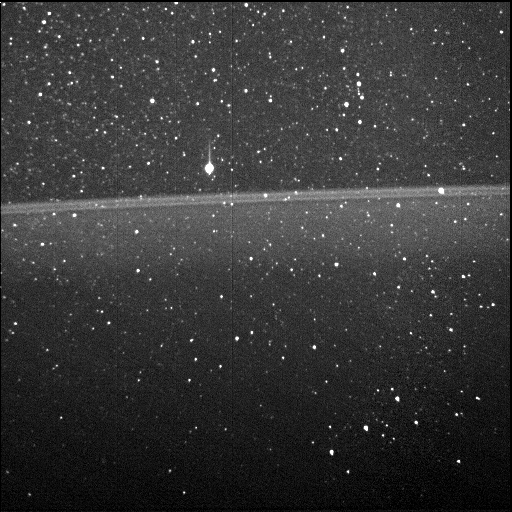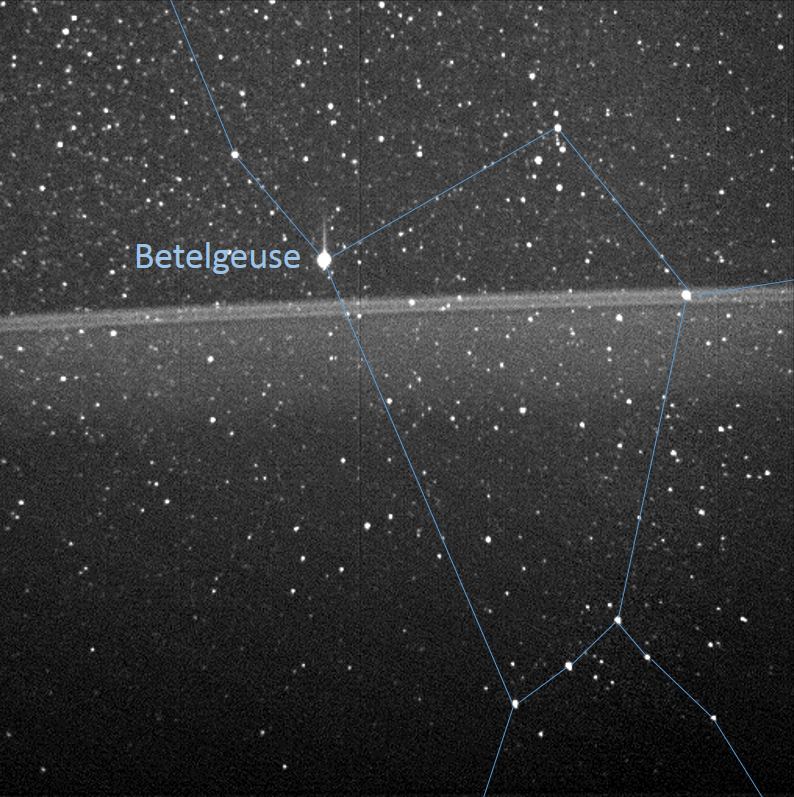Jupiter's Rings from the Inside! First-Ever View Captured by Juno
Humanity now has a new perspective on Jupiter's rings, thanks to NASA's Juno spacecraft.
During its initial data-collecting dive over Jupiter's poles on Aug. 27, 2016, Juno captured the first-ever photo of the giant planet's faint ring system from the inside, mission team members revealed Thursday (May 25).
The photo, which Juno took with its star-tracking navigation camera, also shows part of the constellation Orion, including the bright star Betelgeuse and the three stars that make up Orion's belt. [Photos: NASA's Juno Mission to Jupiter]

"What you're looking at here is a ring of dust that's 40,000 miles [64,000 kilometers] away [from Juno] and stars that are hundreds of light-years away, all in the same picture," Heidi Becker, Juno's radiation-monitoring investigation lead at NASA's Jet Propulsion Laboratory in Pasadena, California, said during a press conference Thursday.
The Juno team wanted to share this glimpse of Jovian stargazing with the world, Becker said. "Heaven looks the same to us from Jupiter," she added.

The $1.1 billion Juno mission launched in August 2011 and arrived in orbit around Jupiter on July 4, 2016. The spacecraft is using its eight science instruments to study the giant planet's structure and composition, as well as its gravitational and magnetic fields. The mission's main goal is to understand how Jupiter formed and evolved, information that should yield insights into the history of solar systems in general, mission team members have said.
Juno collects most of its data during close flyovers of the planet's poles that occur once every 53.5 Earth days. The Aug. 27 dive was Juno's first such "perijove" pass; the probe has since performed four others.
Get the Space.com Newsletter
Breaking space news, the latest updates on rocket launches, skywatching events and more!
Juno's mission is scheduled to end in February 2018.
The newly released photo of Jupiter's rings was a sidelight during Thursday's press conference, which was devoted to discussion of the planet's surprising polar cyclones, mysterious auroras, possibly "fuzzy" core and some other key science results gleaned from Juno's first few perijove passes.
Jupiter's ring system is much smaller and fainter than the famous icy disk that girds Saturn. Galileo Galilei observed Saturn's rings way back in 1610, but Jupiter's weren't spotted until 1979, when NASA's Voyager 1 probe zoomed close to the giant planet. (For the record: Galileo couldn't tell exactly what Saturn's rings were, because his telescope was too crude; the Dutch astronomer Christiaan Huygens was the first to identify them as rings, in 1659.)
"Jupiter's ring system has three main components: a pair of very faint outer rings called the gossamer rings; a wide, flat main ring; and a thick inner ring called the halo," NASA officials wrote on an explainer page about the planet's rings. "The rings appear to be created by dust thrown off by impacts on small moons."
All four of the solar system's giant planets — Jupiter, Saturn, Uranus and Neptune — have ring systems.
Follow Mike Wall on Twitter @michaeldwall and Google+. Follow us @Spacedotcom, Facebook or Google+. Originally published on Space.com.
Join our Space Forums to keep talking space on the latest missions, night sky and more! And if you have a news tip, correction or comment, let us know at: community@space.com.

Michael Wall is a Senior Space Writer with Space.com and joined the team in 2010. He primarily covers exoplanets, spaceflight and military space, but has been known to dabble in the space art beat. His book about the search for alien life, "Out There," was published on Nov. 13, 2018. Before becoming a science writer, Michael worked as a herpetologist and wildlife biologist. He has a Ph.D. in evolutionary biology from the University of Sydney, Australia, a bachelor's degree from the University of Arizona, and a graduate certificate in science writing from the University of California, Santa Cruz. To find out what his latest project is, you can follow Michael on Twitter.









